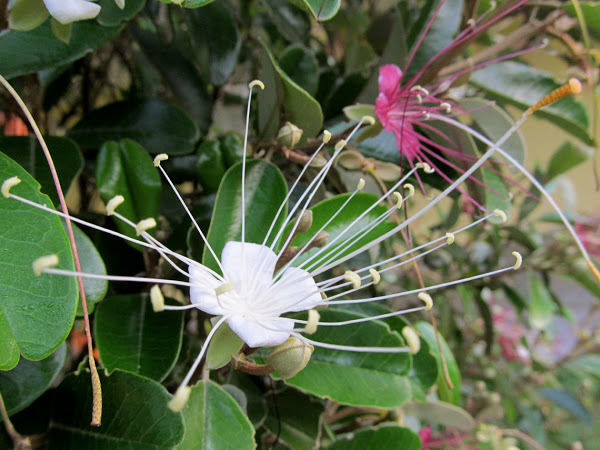Jamaican caper (Capparis Cynophallophora) is a great native plant with a beautiful scent. Originating in the Caribbean, it’s a perfect fit for our South Florida climate. I recently noticed an impressive stand of this native plant when walking through a property on Woodring Road. It has to be the largest Jamaican caper I’ve seen growing wild on the island. It stood at approximately 12 inches high and 6 inches wide and full of white to light purple flowers.
The flowers produce an intense sweet-honey fragrance that draws bees and other beneficial insects, as well as provides the homeowner with a beautiful scented garden. The plant’s blossoms are as lovely to look at as they are to smell. Each bloom is a little four petal bloom with up to 24 stamens spilling out of the center ranging in color from light pink to light purple. While the plant blooms mostly in the spring to early summer, with our high temperatures this fall and winter, I’ve noticed them blooming even at this time of year.
The leaves also possess a natural beauty that cannot be underestimated. The leaves are alternately spaced along the stem and are evergreen with an almost leather-like texture. The upper side of the leaf is dark, glossy green and the underside is covered with tiny tan epidermal scales, with new leaves emerging in a bronze color. The shape of this shrub is usually a large oval or triangular shape. As it ages, it can take on a tree shape with a broad trunk base. You will commonly see them as large trees in the Caribbean islands.
This native is slow growing and can tolerate a lot of salt, wind and poor soil conditions. No wonder it likes the islands and sandy beaches. They will flourish in full sun and survive in lower light, and prefer the warm climate of the islands. They do not like the cold weather.
This plant fits in well as a buffer planting, a specimen or accent plant. While the Jamaican caper is related to the Mediterranean caper used in cooking, this variety is not edible. It does, however, make a great addition to any tropical garden.
This column is a joint effort by all at In The Garden, Sanibel Island’s garden center, located at 3889 Sanibel Captiva Road, Sanibel Island.
